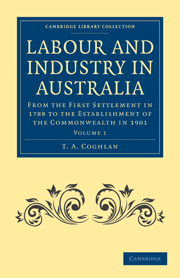 Labour and Industry in Australia
Labour and Industry in Australia Book contents
- Frontmatter
- PREFACE
- Contents
- PART I FROM THE FOUNDATION OF SETTLEMENT TO THE CROSSING OF THE MOUNTAINS
- PART II FROM THE CROSSING OF THE MOUNTAINS TO THE ABOLITION OF THE ASSIGNMENT SYSTEM
- PART III FROM THE ABOLITION OF THE ASSIGNMENT SYSTEM TO THE DISCOVERY OF GOLD
- PART IV FROM THE DISCOVERY OF GOLD TO THE INTRODUCTION OF FREE SELECTION OF LAND BEFORE SURVEY
- I INTRODUCTION TO THE FOURTH PERIOD
- II THE END OF THE CONVICT SYSTEM
III - THE DISCOVERY OF GOLD IN AUSTRALIA
Published online by Cambridge University Press: 05 August 2011
- Frontmatter
- PREFACE
- Contents
- PART I FROM THE FOUNDATION OF SETTLEMENT TO THE CROSSING OF THE MOUNTAINS
- PART II FROM THE CROSSING OF THE MOUNTAINS TO THE ABOLITION OF THE ASSIGNMENT SYSTEM
- PART III FROM THE ABOLITION OF THE ASSIGNMENT SYSTEM TO THE DISCOVERY OF GOLD
- PART IV FROM THE DISCOVERY OF GOLD TO THE INTRODUCTION OF FREE SELECTION OF LAND BEFORE SURVEY
- I INTRODUCTION TO THE FOURTH PERIOD
- II THE END OF THE CONVICT SYSTEM
Summary
In 1839 Count Strzelecki found traces of gold in iron ore at Hartley in the Blue Mountains, but Governor Gipps, fearful of its effects on a convict community, persuaded Strzelecki to keep the discovery secret. Again in 1841 the Rev. W. B. Clarke found grains of gold in a creek near Bathurst. Speaking in England in 1844, Sir Roderick Murehison stated it to be his belief that the Great Dividing Range of Australia would be found to be as rich in gold as the Ural Mountains in Europe. When the Californian gold-fever was causing serious anxiety in New South Wales the possible discovery of gold in the colony assumed a different aspect, and the Governor sent to England for a competent geologist. This was found in the person of Stutchbury, who arrived in Sydney early in 1851. He was told that gold was believed to exist in the neighbourhood of Bathurst; he made a survey of the district and, unfortunately for his reputation, reported that he could trace no indication of the metal in that locality. In the meantime, a colonist named Hargraves, who had seen the gold-diggers at work in California, had convinced himself that gold did exist in considerable quantities in the Bathurst district, and under his guidance the Government geologist was able to confirm the discovery. By the middle of May about four hundred persons were at work on the diggings, and gold began to arrive in Sydney.
- Type
- Chapter
- Information
- Labour and Industry in AustraliaFrom the First Settlement in 1788 to the Establishment of the Commonwealth in 1901, pp. 563 - 587Publisher: Cambridge University PressPrint publication year: 2011First published in: 1918
